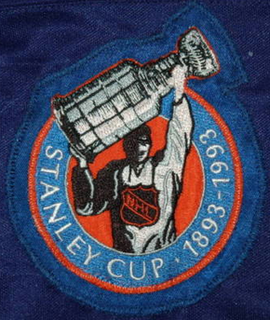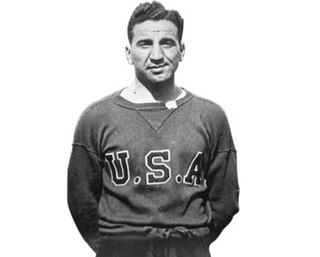
The region Northeast Ohio, in the US state of Ohio, in its most expansive usage contains six metropolitan areas along with eight micropolitan statistical areas. Most of the region is considered either part of the Cleveland–Akron–Canton, OH Combined Statistical Area and media market or the Youngstown–Warren, OH-PA Combined Statistical Area and media market. In total the region is home to 4,502,460 residents. It is also a part of the Great Lakes megalopolis, containing over 54 million people. Northeast Ohio also includes most of the area known historically as the Connecticut Western Reserve. In 2011, the Intelligent Community Forum ranked Northeast Ohio as a global Smart 21 Communities list. It has the highest concentration of Hungarian Americans in the United States.

The 1992–93 NHL season was the 76th regular season of the National Hockey League. Each player wore a patch on their jersey throughout the season to commemorate the 100th anniversary of the Stanley Cup. The league expanded to 24 teams with the addition of the Ottawa Senators and the Tampa Bay Lightning.

The Pittsburgh Hornets were a minor-league professional men's ice hockey team based in Pittsburgh, Pennsylvania.
The Pittsburgh Steelers are an American football franchise representing Pittsburgh. They are the seventh-oldest club in the National Football League (NFL), which they joined in 1933. The only surviving NFL teams with a longer history are the Chicago Bears, Arizona Cardinals, Detroit Lions, Green Bay Packers, New York Giants, and Washington Commanders. The Philadelphia Eagles joined the league concurrently with the Steelers in 1933.

The Cleveland State Vikings, or Vikes, are the athletic teams of Cleveland State University. Before as Fenn College they were known as the Fenn College Foxes or Fenn Foxes. Cleveland State competes in NCAA Division I. The Vikings have competed in NCAA Division I since 1972. They were previously members of the NCAA College Division, a precursor to NCAA Division II. The university is a member of the Horizon League (1994–present), the Mid-American Conference (2019–present) for wrestling, and the ASUN Conference (2021–present) for men's lacrosse. Cleveland State was formerly in the Mid-Continent Conference (1982–1994) and North Star Conference (1989–1992). Cleveland State previously fielded baseball, men's cross country as well as men and women's track and field. As Fenn College they fielded men's ice hockey and rifle. Cleveland State has a number of club sports as well.

Sports in Pittsburgh have been played dating back to the American Civil War. Baseball, hockey, and the first professional American football game had been played in the city by 1892. Pittsburgh was first known as the "City of Champions" when the Pittsburgh Pirates, Pittsburgh Panthers football team, and Pittsburgh Steelers won multiple championships in the 1970s. Today, the city has three major professional sports franchises, the Pirates, Steelers, and Penguins; while the University of Pittsburgh Panthers compete in a Division I Power Five conference, the highest level of collegiate athletics in the United States, in both football and basketball. Local universities Duquesne and Robert Morris also field Division I teams in men's and women's basketball and Division I FCS teams in football. Robert Morris also fields Division I men's and women's ice hockey teams.

Aldo Teo "Buff" Donelli was an American football player and coach, soccer player, and college athletics administrator. He served as the head football coach at Duquesne University from 1939 to 1942, Boston University from 1947 to 1956, and Columbia University from 1957 to 1967, compiling a career college football coaching record of 105–107–8. Donelli was also a head coach in the National Football League (NFL), with the Pittsburgh Steelers for part of the 1941 season and with the Cleveland Rams in 1944, tallying a career mark of 4–11 in the NFL. From 1951 to 1955 he was the athletic director at Boston University. Donelli played college football at Duquesne and was an assistant football coach at his alma mater from 1930 to 1938, before being promoted to head coach. He played soccer with a number of clubs in the 1920s and 1930s and was a member of the United States men's national soccer team during the 1934 FIFA World Cup. He is a member of the National Soccer Hall of Fame.

The Pittsburgh Shamrocks were a professional ice hockey team, based in Pittsburgh, Pennsylvania that played in the International Hockey League in 1935–36. The team played all of its home games at the Duquesne Gardens. During their lone season in existence, the Shamrocks finished in fourth place in the West Division behind the Detroit Olympics, Cleveland Falcons, and Windsor Bulldogs. The Shamrocks scored 137 goals and allowed 170. The team folded after one season. It is estimated that the team lost $36,000 during 1935–36 season.

Roy George "Gus" Giesebrecht was a professional ice hockey centre who played 135 games in the National Hockey League with the Detroit Red Wings. During his career he accumulated 27 goals and 51 assists for a total 78 points. Giesebrecht was widely regarded by fellow players and NHL coaches as one of the most promising rookies in the league at the time. He scored a hat trick in the first period of the first game he saw on-ice action with the Red Wings, and scored the game-winning goal against the Chicago Black Hawks that advanced the Red Wings to the 1941 Stanley Cup Finals.
The Duquesne Dukes football program is the intercollegiate American football team for Duquesne University located in the U.S. state of Pennsylvania. The team competes in the NCAA Division I Football Championship Subdivision (FCS) and is a member of the Northeast Conference.

John Joseph "Rock" Rokisky was a professional American football end and placekicker who played three seasons for the Cleveland Browns, Chicago Rockets and New York Yankees in the All-America Football Conference (AAFC). Rokisky grew up in West Virginia and attended Duquesne University in Pittsburgh, Pennsylvania, where he was a standout as an end and kicker. After a stint in the U.S. Navy during World War II, he joined the Browns in 1946. The Browns won the AAFC championship that year. Rokisky was sent to the Rockets in 1947 and to the Yankees the following year before leaving football.
The Case Western Reserve Spartans football team is the varsity intercollegiate football team representing the Case Western Reserve University, located in Cleveland, Ohio, United States. They compete in the National Collegiate Athletic Association (NCAA) at the Division III level and hold dual membership in both the Presidents' Athletic Conference (PAC) and the University Athletic Association (UAA). They are coached by Greg Debeljak. Home games are played at DiSanto Field. The team in its current form was created in 1970 after the federation of Western Reserve University and Case Institute of Technology.
Ray A. Ride was an American football player, coach, and college athletic administrator. He served as the head football coach at Case Institute of Technology—now known as Case Western Reserve University—from 1930 to 1949, compiling record of 80–77–8. Case honored Ride by changing their fight name from Scientists to Rough Riders in 1940.
The 1937–38 John Carroll Blue Streaks men's ice hockey season was the inaugural season of play for the program.
The 1939–40 John Carroll Blue Streaks men's ice hockey season was the 3rd season of play for the program.
The 1940–41 John Carroll Blue Streaks men's ice hockey season was the 4th season of play for the program.
The 1937–38 Duquesne Dukes men's ice hockey season was the inaugural season of play for the program.
The 1938–39 Duquesne Dukes men's ice hockey season was the 2nd season of play for the program.
The 1939–40 Duquesne Dukes men's ice hockey season was the 3rd season of play for the program.








